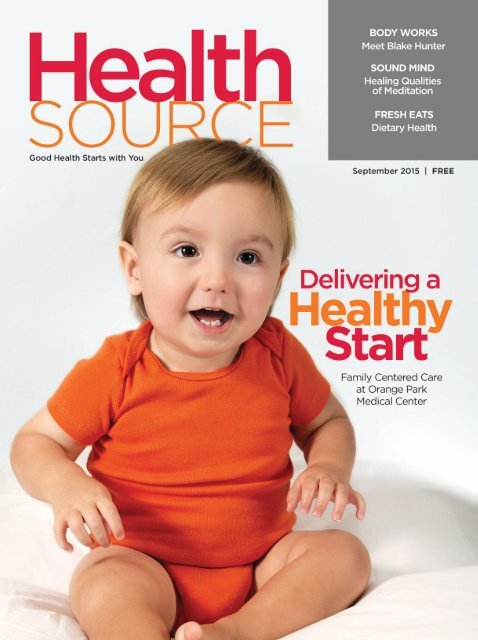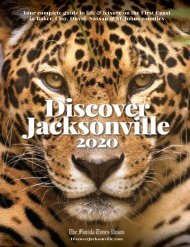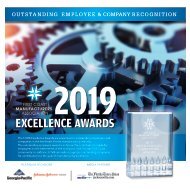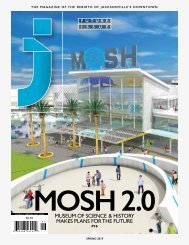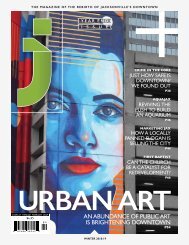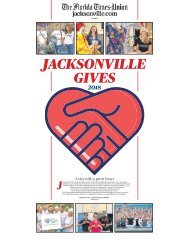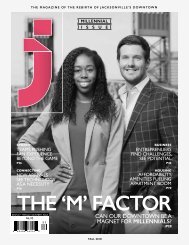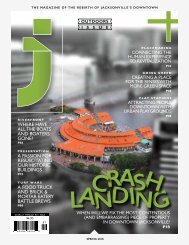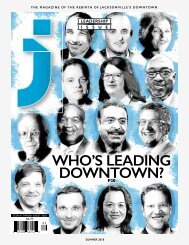HealthSept15
Create successful ePaper yourself
Turn your PDF publications into a flip-book with our unique Google optimized e-Paper software.
SPONSORED CONTENT<br />
Delivering<br />
a Healthy Start<br />
Family Centered Care at Orange Park Medical Center<br />
By Nan Kavanaugh | Cover photography by Woody Huband<br />
When it comes to giving birth, finding the right hospital can be daunting. A balance<br />
between cutting edge technology and a warm, caring environment is what most<br />
seek. At Orange Park Medical Center, synchronizing the best of both worlds for<br />
optimal results is their mission when it comes to family and women’s health.<br />
Dr. Arden Quintin (left) and<br />
Patricia Ebeltoft, RN, BSN, work in the<br />
Level 2 Neonatal Intensive Care Unit<br />
at Orange Park Medical Center.<br />
The NICU is staffed with neonatologists<br />
and advanced neonatal nurse<br />
practitioners, which means babies with<br />
special needs can get the high level of<br />
medical attention they require.<br />
We take a holistic<br />
approach when it comes<br />
to care that is patient<br />
centered rather than<br />
focused on a business model,” says<br />
Dr. Ted Shah, chairman of obstetrics<br />
at Orange Park Medical Center.<br />
“Patient safety is our number one<br />
concern. The path of the patient from<br />
registration to leaving the hospital is<br />
amazing.”<br />
Dr. Shah would know. His practice<br />
alone has delivered upwards of 30,000<br />
babies at Orange Park Medical Center.<br />
“I had a father notice his newborn baby<br />
was jaundiced after they had brought<br />
him home. He had tried to reach out to<br />
the pediatrician, but was told it would<br />
be two weeks before that doctor would<br />
see the baby. So he came back to us.<br />
He said, ‘I feel safe here.’”<br />
Putting the patient first is an essential<br />
element of the philosophy at Orange<br />
Park. The hospital consistently strives<br />
to improve not only its own internal<br />
mechanisms for performance, but also<br />
has worked to provide services needed<br />
within the community. From being<br />
one of the only regional hospitals<br />
with a Level 2 NICU to providing full<br />
spectrum gynecological care, patients<br />
don’t have to transfer to another<br />
hospital when faced with issues that<br />
require specialized services.<br />
“We don’t want to send patients<br />
away to a hospital somewhere else<br />
in the region. We want to keep them<br />
here, with the doctors and nurses they<br />
know,” says OB/GYN Dr. Jade Pizarro.<br />
“This is very reassuring to our patients.<br />
The hospital doesn’t have an urban<br />
inner city feel. We are the only hospital<br />
in Clay County that delivers babies,<br />
and we take a strong community<br />
approach to care.”<br />
Physicians and nurses work together<br />
to provide a seamless experience<br />
for patients. Much of this is due<br />
to specialized training to ensure<br />
collaboration and communication is<br />
excellent. For example, all personnel<br />
providing Labor and Delivery services<br />
were recently required to receive<br />
certification in Electronic Fetal Heart<br />
monitoring, something well taught in<br />
medical training, but as the technology<br />
has progressed, new aspects of routine<br />
monitoring have developed as well.<br />
“When we communicate, we are<br />
all using the same nomenclature.<br />
Nomenclature can vary from institution<br />
to institution, and overall this
“Our patients who come<br />
here know we can take of<br />
all their needs and provide<br />
the very best care. There is<br />
no need to send patients to<br />
another hospital somewhere<br />
else in the region. Our<br />
doctors and staff are highly<br />
trained and tremendously<br />
experienced. This is very<br />
reassuring to our patients.”<br />
— OB/GYN Dr. Jade Pizarro<br />
Orange Park Medical Center designed the labor, delivery and recovery (LDR) room<br />
concept to complete all phases of childbirth in the same room, including services<br />
like one-on-one visits with an experienced, board-certified lactation consultant<br />
like Bronwyn Nickels, RN, IBCLC.<br />
• OPMC provides full<br />
spectrum OB/GYN care<br />
• Level 2 Neonatal<br />
Intensive Care Unit<br />
allows OPMC to serve<br />
babies from 28 weeks to<br />
full term<br />
training has improved our ability to<br />
communicate, improving our quality<br />
of care,” says OB/GYN Dr. Eric<br />
Edelenbos.<br />
In addition to their vast experience<br />
in obstertics, Dr. Edelenbos and<br />
Dr. Shah are regional pioneers in<br />
gynecological robotic surgeries.<br />
People travel from across the region<br />
to receive care at Orange Park. It<br />
is one of the few hospitals with<br />
three da Vinci ® surgical robotic<br />
machines to perform the minimally<br />
invasive, cutting-edge procedures<br />
like hysterectomies or cyst removal.<br />
Investing in this technology was<br />
an investment in optimal patient<br />
outcomes.<br />
“I can perform a regular abdominal<br />
hysterectomy in about an hour and a<br />
half, while it may take me two to three<br />
hours with a robotic procedure,” says<br />
Dr. Edelenbos. “I receive the same<br />
payment for both, but the reason I<br />
perform the robotic surgery is because<br />
the patient will have less recovery<br />
time and less pain. The benefits for<br />
the patient far outweigh the time<br />
saved, and when my patients are<br />
happy, I am happy.”<br />
It is that dedication to providing<br />
optimal outcomes for patients that<br />
is vital to the team at Orange Park<br />
Medical Center. Founded in 1974, the<br />
hospital continues to grow, driven<br />
by the needs of the community it<br />
serves. Its newly opened pediatric<br />
ER, inpatient unit and ICU are a<br />
testimony to that. With Orange Park<br />
having evolved into a comprehensive<br />
tertiary facility, patients no longer<br />
have to go elsewhere for top quality<br />
care, regardless of their needs. Stateof-the-art<br />
services and exceptional<br />
community driven care make this<br />
hospital one of the best in the region.<br />
“We are excellent at all aspects of<br />
women’s care—which is a testament<br />
to the leadership, physicians and staff<br />
at Orange Park. Our sole goal is to<br />
exceed our patients’ expectations.<br />
That’s what the team at Orange Park<br />
is all about.” says Dr. Shah.<br />
• On staff Neonatologist<br />
present at all deliveries<br />
• Obstetric Educator acts<br />
as liaison to keep staff<br />
updated on newest<br />
advancements<br />
• Anesthesia available 24/7<br />
• 22 private rooms for<br />
mother and infant<br />
• Pre and post birth<br />
education<br />
• Breastfeeding support<br />
• 3 da Vinci ® Surgery<br />
Systems for optimal<br />
gynecological<br />
surgery results<br />
2001 Kingsley Ave.<br />
Orange Park, FL<br />
904.579.1106<br />
orangeparkmedical.com
letter from the publisher ••••<br />
PUBLISHER<br />
A.J. Beson<br />
EXECUTIVE VICE PRESIDENT<br />
Michael E. Hicks<br />
EDITOR / COMMUNITY MANAGER<br />
Nan Kavanaugh<br />
ART DIRECTOR<br />
Christine Tarantino<br />
DIRECTOR OF BUSINESS DEVELOPMENT<br />
Stephanie Calugar<br />
MARKETING CONSULTANTS<br />
Alaina Record<br />
Joy Bell<br />
Adam Farmer<br />
Nikki Schonert<br />
GRAPHIC DESIGNERS<br />
Courtney Cooper<br />
Andy Gattis<br />
COPY EDITOR<br />
Sarah Musil<br />
CONTRIBUTING WRITERS<br />
Sarah Brodsky<br />
Bob Fernee<br />
Allie Olsen<br />
Eleanor Snite<br />
Jon Vredenburg<br />
CONTRIBUTING PHOTOGRAPHER<br />
Woody Huband<br />
PROJECT MANAGER AND<br />
SOCIAL MEDIA STRATEGIST<br />
Stacey Steiner<br />
PROJECT MANAGER<br />
Chris Day<br />
FINANCIAL OFFICER<br />
Sonia Wellington<br />
AGENCY ACCOUNT COORDINATOR<br />
Michael Bridge<br />
VIDEO PRODUCTION SPECIALIST<br />
Grace Walsh<br />
Stock photography provided by Thinkstock<br />
Running a full-time publishing company,<br />
operating a full-service marketing agency, being<br />
a supportive husband, tending to four children,<br />
it causes me a little bit a stress and anxiety just<br />
thinking about it.<br />
We are all human and deal with<br />
stress in our own ways. Some<br />
people enjoy reading books to<br />
calm down, some hit the gym, and<br />
some go for a brisk jog around the<br />
neighborhood. It’s important to<br />
have a coping mechanism to get<br />
through these moments. One thing<br />
that I’ve recently picked up on is<br />
taking part in breathing exercises<br />
a few times throughout the daily<br />
grind.<br />
Nowadays, people usually find<br />
they relax best by tuning in to<br />
their favorite sitcom in the evening<br />
time with a glass of wine or beer.<br />
But really that does nothing to<br />
reverse the effects of stress on<br />
our well-being and livelihood.<br />
It’s essential to take the time to<br />
sit back and breathe in new life.<br />
Practicing deep breathing is a<br />
very simple but great technique<br />
to adopt into your lifestyle. It’s<br />
the foundation to many relaxation<br />
practices around the world. Truly,<br />
all you need is some time to<br />
yourself, a place to lay down, and<br />
maybe some calming, tranquil music.<br />
Stress is an important part of life, but<br />
you have to know when too much<br />
is too much. This issue focuses on<br />
the power of breath and the organ<br />
that controls it, the lungs. I hope<br />
you enjoy this issue of HealthSource<br />
Magazine!<br />
Best Regards,<br />
HealthSourceMag.com<br />
HealthSource is published by Beson4 Media Group, 13500<br />
Sutton Park Drive South, Suite 105, Jacksonville, FL 32224,<br />
904.992.9945. Content of the contributing advertisers do not<br />
reflect the opinions of Beson4 Media Group. Advertisers have<br />
proofed respective articles and content is assumed true and<br />
correct. HealthSource is not responsible for the care given by<br />
its advertisers. HealthSource is for informational purposes only<br />
and is not meant as medical advice. HealthSource believes that<br />
choosing a medical professional is a serious decision and should<br />
not be based solely on an advertisement. © 2015 HealthSource,<br />
Inc. All rights reserved. The contents of this publication including<br />
articles, may not be reproduced in any form without the<br />
written permission from the publisher.<br />
A.J. Beson<br />
CEO & Publisher<br />
aj@beson4.com<br />
4—HealthSource September 2015
28<br />
September 2015<br />
contents<br />
13<br />
Features<br />
13 Meet Blake Hunter<br />
This soon-to-be<br />
2-year-old ambassador<br />
will lead the 2015<br />
First Coast Heart Walk<br />
this month.<br />
24 Meditation<br />
Can breathing really<br />
help you heal? This<br />
activity (or lack<br />
thereof) continues<br />
to gain in popularity,<br />
with millions of<br />
people drawing on the<br />
principles for mental<br />
and physical wellness.<br />
28 Fat Chance<br />
Eating a low fat diet<br />
is not just good for<br />
your waistline, it is also<br />
good for your heart.<br />
BODY WORKS<br />
10 Best Foot Forward<br />
Tips and tricks to help<br />
put you in first place.<br />
16 Exercise of the Month<br />
Playing with your kids can<br />
be excellent exercise for<br />
the whole family.<br />
18 Ask the Expert<br />
Dr. Jannifer Harper,<br />
LUNG FORCE Run Walk<br />
Chair talks lung health<br />
and what you can do to<br />
breathe better.<br />
SOUND MIND<br />
23 Healthy Minute<br />
6 facts about the healing<br />
power of breathing.<br />
FRESH EATS<br />
32 What’s On Our Plate<br />
A diet that includes pasta<br />
and wine? Yes, please. We<br />
give you a breakdown of<br />
the Mediterranean Diet.<br />
24<br />
6—HealthSource September 2015
Over the past decade, we have increasingly grown to serve our patients in Northeast Florida.<br />
For patient convenience, we are moving our main location, 3900 University Blvd. South,<br />
Jacksonville to 7011 AC Skinner Parkway, Jacksonville starting in SEPTEMBER 2015. Our new office,<br />
equipped with more exam rooms and more parking, will reduce wait time for patients because<br />
quality care comes first.<br />
OUR NEW HOME IS AT:<br />
7011 AC SKINNER PARKWAY, JACKSONVILLE<br />
904.493.3333<br />
We will maintain our outpatient Catheterization Lab on University Blvd. while all of our other locations will remain the<br />
same. Visit our new location for improved quality, the same lower out-of-pocket costs and the same expert team.<br />
www.firstcoastcardio.com
FIND IT<br />
Online<br />
/ healthsourcemagazine / healthsourcemag<br />
@healthsourcemag<br />
/ healthsourcemag<br />
Back-to-School<br />
Lunch Box:<br />
Visit our website<br />
for kid friendly<br />
lunchbox tips to<br />
get their school year<br />
off to a good start.<br />
Cooking with Heart:<br />
Keeping your heart healthy<br />
starts at the table. Check out<br />
some heart healthy recipes<br />
online.<br />
Take a<br />
Deep<br />
Breath!<br />
Want to get<br />
started with a<br />
meditation<br />
routine? Visit<br />
us online for<br />
a guide.<br />
8—HealthSource September 2015
September 2015<br />
healthsourcemag.com—9
BODY WORKS • • • • Best Foot Forward<br />
One Breath at a Time<br />
By Bob Fernee<br />
It was a 5k-road race, and I wanted to run well.<br />
In fact, I was going for a new personal record,<br />
my fastest ever. I believed that I had trained well,<br />
and that the time was right. Chasing after the<br />
hoped-for goal, I started the race quicker than<br />
usual. The 3.1-mile race was about half way over,<br />
when I began to run into trouble.<br />
Was the pace too much? Had I<br />
started too fast? My heart rate<br />
raced, my legs felt heavy and<br />
worst of all, my breathing was labored. I<br />
couldn’t get enough air. I felt like I was<br />
dying. With over a mile left, my hope<br />
of running a personal record seemed as<br />
far away as some of the runners in front<br />
of me.<br />
I knew I had to catch my breath and<br />
recover. I momentarily slowed down<br />
and took in as many deep breaths as<br />
possible. Then, I tried to regain my pace<br />
while concentrating on my running<br />
10—HealthSource September 2015
form, and pushed on until the finish<br />
line. When it was over, I was not only<br />
pleased with my time, but how I had<br />
fought my way out of trouble.<br />
There are two types of running:<br />
aerobic running, which is when<br />
you comfortably run, by taking<br />
in enough oxygen to supply your<br />
body’s immediate needs. Then there<br />
is the opposite: anaerobic running.<br />
At one time or another, every runner<br />
experiences it. Your oxygen supply<br />
cannot keep up with demand; you<br />
are out of breath, and without enough<br />
oxygen lactic acid builds up in the legs<br />
and running seems nearly impossible.<br />
What can you do?<br />
Pace yourself: You might have<br />
started too fast, causing you to go into<br />
“oxygen debt.” Begin slower and build<br />
into your run. If you run with others<br />
remember the “talk test”—if you can’t<br />
talk as you are running, then you’re<br />
probably going too fast.<br />
Breathe properly: Some people<br />
suggest that you should breathe in with<br />
the nose and out through the mouth,<br />
but this is not correct. You cannot get<br />
nearly enough air that way. Breathe<br />
in and out with both mouth and nose.<br />
Breathe in as deeply as possible into<br />
the lungs and diaphragm. Too many<br />
people take shallow breaths; this can<br />
cause a “stich,” a painful condition<br />
that can stop you in your tracks. Local<br />
runner, Jerry Lawson, who once held<br />
the American record in the marathon,<br />
says, “Try to get a rhythm going<br />
with your breathing in cadence with<br />
your strides.” Undoubtedly, running<br />
rhythmically means less effort and<br />
greater efficiency.<br />
Train for it: Elite runners know<br />
that anaerobic running is part of racing,<br />
and they train themselves to endure it.<br />
They are constantly trying to delay it by<br />
increasing their anaerobic threshold, or<br />
“pain barrier.” In a race, they will say<br />
things to themselves like: “I have felt<br />
this pain many times before, I beat it<br />
then and I can beat it now.”<br />
Beach Boulevard: 14444 Beach Blvd., Suite B, Jacksonville<br />
Jacksonville Arlington: 929 University Blvd., Jacksonville<br />
Memorial Plaza: 3901 University Blvd., Suite 111, Jacksonville<br />
Dunn Avenue: 1215 Dunn Avenue, Suite 8, Jacksonville<br />
Clay County: 1784 Blanding Blvd., Middleburg<br />
Regency: 9535 Regency Square Blvd. N., Jacksonville<br />
Jacksonville South At Home: 14965 Old St. Augustine Rd., Unit 114, Jacksonville<br />
Call us at 904-463-1635 to schedule a tour of the dialysis<br />
centers and find out how DaVita’s personalized approach<br />
to kidney care can improve your quality of life.<br />
For one of the world’s best sources for kidney care-related<br />
articles, recipes, tools and more, visit DaVita.com<br />
September 2015<br />
healthsourcemag.com—11
We’re the dreamers<br />
and schemers that build<br />
brands beyond the<br />
ordinary.<br />
Through creative<br />
strategy, Beson4 Media<br />
Group discovers what<br />
sets you apart from<br />
the competition. From<br />
a team of advertising<br />
experts to our mixologist<br />
of media, we’ll help you<br />
craft a message that<br />
will persuade and build<br />
a strategy that’s sure<br />
to impact your target<br />
audience. It’s what we<br />
do. We’ll make your<br />
messages matter.<br />
904.992.9945 I www.beson4media.com<br />
13500 Sutton Park Drive South, Suite 105<br />
So, how can we help you<br />
stand out? – Because,<br />
you just gotta be you.<br />
12—HealthSource September 2015
BODY WORKS ••••<br />
September 2015<br />
By Eleanor Snite<br />
healthsourcemag.com—13
hen you see Blake Hunter on the playground, you<br />
would never guess that he has already gone through<br />
multiple heart surgeries. When the toddler was just<br />
30 hours old, doctors realized that something was<br />
wrong with his heart. He had a small hole in the bottom<br />
of his heart and a main artery. He was transferred to<br />
Wolfson Children’s Hospital NICU. Blake had his first<br />
heart surgery at 9 days old. The surgery took eight hours.<br />
It was any new parents’ nightmare. Two months later,<br />
Blake and his parents were finally allowed to go home.<br />
Blake Hunter will be two years old in October,<br />
and he has already had two open heart surgeries<br />
and two heart catheterizations. Because the conduit<br />
in his heart is artificial, as he grows he will have to<br />
have a bigger conduit inserted on a regular basis,<br />
and there could be other issues that might need<br />
a surgical intervention. This is why Blake will be<br />
leading the American Heart Association’s First Coast<br />
Heart Walk on Saturday, Sept. 19, from Metropolitan<br />
Park. Friends and family will be walking with him,<br />
celebrating how far how he has come.<br />
“He’s doing fabulously right now and has been<br />
since his last catheterization in October,” says his<br />
mother, Angela Hunter, who along with Blake’s dad,<br />
Jody Hunter, will be walking. “He will definitely<br />
want to walk and wander around to see things and<br />
other people.”<br />
Each year the AHA looks for a family with a<br />
compelling story to lead the Heart Walk, and the<br />
Hunters fit the bill. Blake came to the attention of<br />
the AHA staff when he visited the cardiovascular<br />
intensive care unit at Wolfson Children’s Hospital<br />
after a doctor’s appointment. The AHA was there<br />
with beauty queens giving out handmade blankets.<br />
Angela said the beauty queens and the AHA staff fell<br />
in love with Blake. The staff got together with the<br />
family later, and they learned about each other.<br />
“We have had really amazing support from<br />
everybody through this whole experience,” Jody<br />
Hunter says.<br />
Blake also made a major impression on Darnell<br />
Smith, North Florida marketing president at Florida
HealthSource Publisher<br />
AJ Beson, Heart Walk<br />
Sponsor, with Blake and<br />
his mother Angela at a<br />
Heart Walk Executive<br />
Event.<br />
Blue, who is the 2015 First Coast Heart Walk<br />
chairman. Smith said he recently attended an<br />
event for the Heart Walk at EverBank Field. He<br />
stepped out of an elevator, and the first person<br />
he saw was Blake wearing a little red cape and<br />
running around.<br />
“I was just taken by this kid,” Smith says. “It<br />
gave me that much more motivation to do this,<br />
just knowing his story, what he’s going through,<br />
what his family is going through and that we<br />
can make a difference.”<br />
Smith, who was on the executive leadership<br />
team for the 2014 walk, last year lead the<br />
executive challenge, which encourages<br />
executives to donate to the walk and get other<br />
executives to do the same. He was asked by<br />
Terry West, last year’s walk chairman, to be the<br />
chairman this year, and he was happy to do it.<br />
“I’m really excited about it,” Smith says.<br />
“There are great colleagues on the leadership<br />
team, and when I think about 20,000 people out<br />
there on Sept. 19th—I just love the work we’re<br />
doing. It’s the largest single fund-raising walk in<br />
Jacksonville.”<br />
Blake’s story inspired Dr. Leslie Cooper,<br />
chairman of the department of cardiovascular<br />
diseases at Mayo Clinic in Florida as well.<br />
She saw a video of Blake on the Internet and<br />
thought he was “adorable”.<br />
Cooper came to Jacksonville in February of<br />
this year and almost immediately was asked<br />
to be in charge of rallying the Mayo staff to<br />
walk in the Heart Walk. Cooper specializes in<br />
myocarditis (heart muscle inflammation), the<br />
third leading cause of cardiac sudden death in<br />
young adults. He had been working for many<br />
years with the American Heart Association at the<br />
national level but never on a local level. Cooper<br />
says he accepted the leadership for Mayo<br />
Florida and a spot on the executive leader team<br />
to support the local Heart Association and to be<br />
a good citizen in his new community.<br />
Cooper says Mayo in Florida focuses on rare<br />
and undiagnosed cardiac conditions, and heart<br />
disease is one of its five primary emphasized<br />
service lines. The Heart Walk attracts more than<br />
1,000 Mayo Florida staff each year, Cooper says.<br />
They are recruited through a variety of ways.<br />
During an onsite sign up event, previous team<br />
captains talk about their experience and others<br />
talk about their experience with heart disease.<br />
“While the primary focus of the walk is fund<br />
raising, it also has a lot of health awareness,”<br />
Cooper said. “I like being able to help people<br />
who have uncommon diseases like myocarditis.”<br />
Lisa Craig, communications director for the<br />
local AHA, says the event is pet friendly—there<br />
will even be a Top Dog photo contest. There<br />
will also be information about healthy living<br />
and plenty of fun activities for children. The<br />
festivities start at 8 a.m. on Sept. 19th and the<br />
three-mile walk starts at 9 a.m.<br />
Last year, 15,000 people participated in the<br />
2015 First Coast Heart Walk. It’s usually 18,000,<br />
but it rained in 2014. This year the goal is 20,000<br />
people. Last year’s walk brought in $1.2 million<br />
and the goal for this year is $1.75 million.<br />
For more information, visit<br />
FirstCoastHeartWalk.org.<br />
September 2015<br />
healthsourcemag.com—15
BODY WORKS • • • • Exercise of the Month<br />
Play More,<br />
LIVE<br />
HEALTHIER<br />
Exercise with your kids<br />
By Bob Fernee<br />
How do you get your kid off the couch and moving? The difficulties faced by children in regards to exercise are much<br />
the same as those that plague adults: lack of time, little motivation and not much enjoyment. The reasons for doing<br />
exercise are largely the same: An increased feeling of well-being, including more self-confidence and self-esteem,<br />
weight loss/control, improved athletic performance, less risk of illnesses such as diabetes and high blood pressure.<br />
The American Heart Association recommends that children get at least 60 minutes of moderate-to-vigorous aerobic<br />
activity every day. A good goal is to reduce non-active time by 30 minutes a day and increase physically active time<br />
by 30 minutes. Parents can help by making physical exercise fun; the more fun it is then the less the child will view it<br />
as exercise. If parents are involved, kids are much more likely to continue.<br />
Here are a few ideas that should help the kids, and you, become more active and fit.<br />
Running:<br />
It doesn’t have to be punishment<br />
and pain. Take the kids out the<br />
door, start with an easy jog, then<br />
pick a landmark 40 or so yards<br />
ahead (a lamppost, mailbox, etc).<br />
Challenge them to a race to that<br />
spot, jog some more (to recover),<br />
then race to another target. Kids<br />
love to race! They won’t even<br />
realize that they are exercising.<br />
Soccer:<br />
No kid hates running when<br />
he has a ball at his feet. Set up<br />
a couple of goals, you can use<br />
anything; old sneakers will do, then<br />
let play begin. The sprinting will<br />
soon get the heart pumping. You<br />
can even play soccer in the garage<br />
if you want some shade. A small<br />
foam ball with two improvised<br />
“goals” made from garage items,<br />
like buckets or tool boxes, is all you<br />
need to get your game on.<br />
Kickball:<br />
This old game seems to have<br />
fallen on hard times, but it is a fun,<br />
simple game that provides great<br />
exercise. Four bases (those same<br />
old sneakers will do fine) and a<br />
kickball, that’s it. Short sprints<br />
around the bases, with plenty of<br />
down time in between makes it a<br />
great sport for kids who are just<br />
getting into athletics.<br />
16—HealthSource September 2015
BENEFITTING BAPTIST HEALTH AND WOLFSON CHILDREN’S HOSPITAL<br />
For sponsorship information and registration, please visit foundation.baptistjax.com/golf<br />
or contact Baptist Health Foundation at 904-202-2919.<br />
PRESENTED BY:<br />
September 2015<br />
healthsourcemag.com—17
BODY WORKS • • • • Ask The Expert<br />
Q&A<br />
“Lung cancer is the number<br />
one cancer killer of women,<br />
not breast cancer. The<br />
largest risk for lung cancer is<br />
controllable by not smoking.”<br />
— Dr. Jannifer Drake Harper<br />
Jannifer Drake Harper, MD, CPE<br />
Vice President and Chief Medical Officer of Florida Blue<br />
and LUNG FORCE Run Walk Chair<br />
We asked Dr. Harper to share with our readers facts about<br />
lung disease, and how to better care for one of our body’s<br />
most important organs…the lungs.<br />
Dr. Jannifer Drake Harper<br />
QWhy is it important to raise<br />
awareness about lung health?<br />
Lung cancer is the number one<br />
cancer killer of women, not breast<br />
cancer. The largest risk for lung<br />
cancer is controllable by not<br />
smoking.<br />
QIf you don’t smoke, are you still<br />
at risk for lung disease?<br />
Smokers are not, however, the only<br />
people who get lung cancer. About<br />
10 percent of people diagnosed with<br />
the disease never smoked.<br />
QWhat are some warning signs<br />
that you may be suffering from<br />
lung disease?<br />
Abnormal breathing pattern,<br />
coughing, chest pain, chest<br />
tightness, and shortness of breath<br />
are all warning signs.<br />
QDoes air pollution play a factor<br />
in lung health?<br />
Pollution does impact lung health,<br />
and there are several things that you<br />
can do. Pollutants of major public<br />
health concern include particulate<br />
matter, carbon monoxide, ozone,<br />
nitrogen dioxide and sulfur dioxide.<br />
Common sources of poor indoor<br />
air quality that should be avoided<br />
include:<br />
•cigarette smoking—no one<br />
should smoke indoors.<br />
•mold or mildew<br />
•household cleaners<br />
•household chemicals<br />
•scented products<br />
•pesticides<br />
•radon gas<br />
•wood smoke<br />
•Pressed-wood office furniture<br />
and carpet can be a source of<br />
formaldehyde.<br />
•Poor ventilation can exacerbate<br />
asthma and allergies.<br />
18—HealthSource September 2015
How can we take better<br />
Q care of our lungs?<br />
Don’t smoke and avoid second<br />
hand smoke.<br />
Q<br />
Lungs are an amazing<br />
organ. Can you share with<br />
our readers some extraordinary<br />
facts about lungs?<br />
You have two lungs that are<br />
not the identical size—the lung<br />
on the left side is smaller than<br />
the right—to make room for<br />
the heart. Lungs consist of 300<br />
million capillaries (tiny blood<br />
vessels)—if they were laid out<br />
they would span 1,500 miles.<br />
This is where oxygen enters<br />
the blood and carbon dioxide<br />
is taken out. There are several<br />
tubes that unite your mouth to<br />
the insides of your lungs. Your<br />
trachea (or wind pipe) is the<br />
large tube you can sense in your<br />
gullet. This divides into core<br />
stem bronchi, which then split<br />
many further times into minute<br />
tubes called bronchioles. There<br />
are about 30,000 bronchioles<br />
in our lungs! At the end of all<br />
of these tiny tubes are small<br />
sacks called alveoli. These get<br />
larger and smaller with every<br />
breath, and hold lots of blood<br />
vessels which is where oxygen<br />
enters the blood and ravage (like<br />
carbon dioxide) leaves the blood.<br />
September 2015<br />
healthsourcemag.com—19
SPONSORED CONTENT<br />
Jacksonville<br />
Spine Center<br />
Practice expands with the addition of Dr. Michael Hanes<br />
By Maggie FitzRoy<br />
Dr. Michael Hanes recently<br />
treated a patient who had<br />
sustained injuries in an<br />
accident which were so<br />
debilitating that she could no longer<br />
work, due to severe back pain.<br />
When Dr. Hanes treated her with a<br />
combination of advanced techniques<br />
and procedures, she recovered so<br />
well that she was able to go back to<br />
work and resume her normal life.<br />
“I was very pleased to see her<br />
progress, and she seemed grateful,”<br />
says Dr. Hanes, an interventional pain<br />
management physician at Jacksonville<br />
Spine Center, which has provided stateof-the-art,<br />
clinically proven solutions<br />
for pain for more than 15 years.<br />
Dr. Hanes joined Jacksonville<br />
Spine in July, expanding the practice<br />
at 10475 Centurion Parkway in<br />
Jacksonville to four interventional<br />
pain management physicians.<br />
In addition to Dr. Christopher<br />
Roberts, who founded the center, Dr.<br />
Hanes joins Dr. Claudio Vincenty and<br />
Dr. John Carey.<br />
Dr. Hanes did his fellowship<br />
in interventional pain medicine<br />
at University Hospitals Case<br />
Medical Center in Cleveland, Ohio<br />
after completing a residency in<br />
Anesthesiology there. He and his<br />
wife, Samantha, moved to the<br />
First Coast to be near her family,<br />
and he was excited to join<br />
Jacksonville Spine Center.<br />
Interventional pain management<br />
is a rewarding specialty, because<br />
“chronic pain can be one of the<br />
most challenging conditions to treat<br />
in medicine,” he says. “It is always<br />
my goal to get my patients’ pain<br />
controlled so that they can be active<br />
again and return to the quality of life<br />
they once enjoyed.”<br />
Jacksonville Spine focuses on<br />
providing highly individualized<br />
patient care, working closely with<br />
each patient to develop a treatment<br />
program specific to their needs<br />
that will eliminate their pain and<br />
improve their quality of life. They<br />
use the latest advanced techniques,<br />
including interventional procedures,<br />
medication management and<br />
rehabilitation. These include stem<br />
cell therapy, spinal cord stimulation,<br />
spinal drug delivery and radio<br />
frequency lesioning, which involves<br />
deactivating sensory nerves that<br />
supply joints in the spine and other<br />
parts of the body.<br />
“Interventional pain management<br />
has made tremendous advancements<br />
through research and technology,<br />
and I have seen patients do very<br />
well utilizing these new therapies for<br />
conditions that previously could not<br />
be treated,” Dr. Hanes says. It is also<br />
a specialty that allows him to get to<br />
know his patients on a personal level,<br />
which he finds personally gratifying.<br />
10475 Centurion Pkwy. N. #201<br />
Jacksonville, FL 32256<br />
(904) 223-3321<br />
www.jaxspine.com<br />
“It is always my goal<br />
to get my patients’ pain<br />
controlled so that they<br />
can be active again and<br />
return to the quality of life<br />
they once enjoyed.”<br />
— Dr. Michael Hanes<br />
September 2015<br />
healthsourcemag.com—21
Technology shouldn’t be the biggest obstacle in your day. The solution for your<br />
IT needs is a simple one. Brightlink Technology provides a comprehensive list<br />
of services that are designed to proactively prevent issues before they arise<br />
providing quick, professional and reliable solutions around the clock.<br />
OVERVIEW OF SERVICES<br />
Managed IT Services and 24/7 Lights-On Support<br />
• Infrastructure Security<br />
• Server and Desktop Support<br />
• Secure Local and Remote Access<br />
• Disaster Recovery<br />
Technology Administration and Management<br />
• Hardware and Software Management<br />
• Network and Data Access Provisioning<br />
• Software Licensing Management<br />
• Environment Reporting and Documentation<br />
Cloud Services<br />
• Secure Online Backup<br />
• Managed Spam and Antivirus<br />
• Exchange, SharePoint and Website Hosting<br />
• Private Cloud and Office Virtualization<br />
Call us at: 904.619.1966<br />
13500 Sutton Pk Dr South, Ste 105, Jacksonville, FL 32224<br />
www.brightlinktech.com
SOUND MIND • • • • Healthy Minute<br />
TAKE A<br />
DEEP<br />
BREATH<br />
Compiled by Nan Kavanaugh<br />
The healing power of breathing<br />
Think about how many times you have told yourself to take a deep breath. It could be walking<br />
into a big job interview in an effort to steady your nerves, or maybe it was to curb growing<br />
frustration with an angry toddler? Either way, we often use breathing to help us keep our cool.<br />
Here are some facts on why lung health is essential to our overall wellbeing.<br />
1. Our bodies<br />
expel 70<br />
percent of<br />
its toxins<br />
through<br />
breathing.<br />
When you<br />
take shallow<br />
breaths, your<br />
body has to<br />
work harder<br />
to detoxify.<br />
2. Deep<br />
breathing<br />
increases<br />
your energy<br />
level and<br />
improves<br />
blood<br />
circulation<br />
through<br />
oxygenation.<br />
3. When you take<br />
a deep breath,<br />
endorphins are<br />
released into<br />
your body.<br />
Endorphins act<br />
like painkillers<br />
and can relieve<br />
headaches,<br />
sleeplessness,<br />
backaches and<br />
other stress<br />
related aches<br />
and pains…<br />
and make you<br />
happier.<br />
4. A long, slow<br />
breath is the<br />
fastest way to<br />
stimulate the<br />
parasympathetic<br />
nervous<br />
system, a.k.a.<br />
the relaxation<br />
response.<br />
5. Deep<br />
breathing<br />
increases<br />
your cardio<br />
capacity,<br />
similar to<br />
exercise, and<br />
can help burn<br />
fat cells.<br />
6. Giving more<br />
oxygen to<br />
your body<br />
increases<br />
your overall<br />
organ<br />
strength, and<br />
gives your<br />
heart a bit of<br />
a break when<br />
trying to<br />
move blood<br />
with oxygen<br />
to tissues.<br />
September 2015<br />
healthsourcemag.com—23
SOUND MIND ••••<br />
Can Breathing Really Help You Heal?<br />
By Sarah Brodsky<br />
Meditation has<br />
been practiced for<br />
thousands of years.<br />
Most reports have<br />
it dating back more<br />
than 5,000 years in<br />
the East, although<br />
the Western tradition<br />
of meditation<br />
really began to gain<br />
traction in the 1960s<br />
and 1970s. Since<br />
then, meditation<br />
has continued to<br />
gain in popularity,<br />
with millions of<br />
people drawing on<br />
the principles for<br />
mental and physical<br />
wellness.<br />
The word “meditate” comes from the Latin root<br />
meditatum, i.e. to ponder. However, in practice,<br />
meditation is actually the opposite, at least when<br />
it comes to pondering thoughts. Meditation,<br />
according to Mayo Clinic’s website, is intended to<br />
be a deliberate removal of all random thoughts of<br />
the past or future, with the intent to focus only on the present<br />
moment.<br />
“There are countless studies that have been conducted on the<br />
health benefits of yoga and meditation,” says Alva Roche-Green,<br />
M.D., a family medicine physician and pediatrician at Mayo<br />
Clinic. Stress, pain and anxiety, says Dr. Roche-Green, weaken<br />
the immune system. By improving stress levels, one can hopefully<br />
improve their immune system. And meditation, says Dr. Roche-<br />
Green, is a great tool.<br />
“Meditation can help reduce overall stress levels and has been<br />
shown to help with fatigue as well as improvement in blood<br />
pressure and heart rate,” says Green.<br />
There are many studies showing the significance of breathing<br />
exercises. But perhaps more significant are the actual experiences<br />
of those who live—and breathe—the practice. Meditation happens<br />
naturally, when you direct all of your attention to the present<br />
moment, allowing all distractions to fade away. In a meditative<br />
state, your breath and brain activity slow down, which in turn,<br />
helps bring more oxygen to your body<br />
While breathing is a natural act, in the practice of meditation it is<br />
very focused.<br />
“Regardless of the type of meditation practice, by placing your<br />
undivided attention on your breath or other bodily sensations, you<br />
24—HealthSource September 2015
How to get started:<br />
1. Be open to meditation.<br />
“Be willing to suspend<br />
judgement on how it’s<br />
supposed to be and just<br />
try it,” says Haridan.<br />
2. Practice makes perfect.<br />
Almost everyone agrees:<br />
it can be difficult to reach<br />
a meditative state the<br />
first time you try. But<br />
stick with it. Schatz says<br />
a common complaint she<br />
hears from beginners, is<br />
“it’s hard to concentrate.”<br />
“Overstimulation from our<br />
environment and constant<br />
distractions from the past<br />
and future have trained our<br />
brains to avoid being still<br />
and present in the moment,”<br />
she says. But meditation and<br />
mindfulness-based practices<br />
can help you retrain your<br />
brain and body. “You just<br />
have to stick with it and<br />
practice.”<br />
3. Try different practices.<br />
Around the First Coast,<br />
there are countless yoga<br />
studios and practitioners<br />
offering meditation and<br />
similar eastern modalities.<br />
Try several to find the style<br />
and practitioner that speaks<br />
to you. “Everyone has their<br />
own path. If you start with<br />
something and not getting<br />
results you desire, be willing<br />
to try another one,” says<br />
Haridan.<br />
4. Be gentle on yourself.<br />
“Cultivating a state of<br />
meditative awareness takes<br />
time and will continue over<br />
the course of a lifetime.<br />
Some days will be easier<br />
than others, and it’s<br />
important to remember to<br />
not beat yourself up along<br />
the way,” says Schatz.<br />
are always in the present moment,” says Kristi Lee Schatz, a certified<br />
teacher and director of Wellness Programs for Unity Plaza Center,<br />
which is offering meditation and relaxation courses to local residents.<br />
“Your breath is always in the present moment and serves as an<br />
anchor to help you regain focus when distractions arise.”<br />
But in meditation, not all breaths are the same. For Carol Meyer,<br />
of Jacksonville Beach, transformational breath work (TB) is a specific<br />
technique that she was introduced to almost two decades ago.<br />
“TB is a continuous, connected, circular belly breath done with<br />
an open mouth with emphasis on the inhale and a relaxed exhale,”<br />
Meyer says. “In TB, you are breathing in life force, your goodness in<br />
life and exhaling toxins—physically, mentally and emotionally. By<br />
doing TB I can get clarity and a grounded, calm, peaceful space of<br />
oneness in my life to focus on what’s really important.”<br />
Florence Haridan, owner of Conscious Eats, who works with<br />
underserved populations, began meditating almost two decades ago<br />
to cope with pain from an old auto accident and chronic migraines.<br />
Today, her practice includes individual daily meditation as well as<br />
instructor-led guided visualization.<br />
In the beginning, she says, “I had to let go of prejudices and had<br />
to suspend some of my beliefs of where my mind and body could<br />
go. But it’s paid off.”<br />
26—HealthSource September 2015
Unity Plaza in Brooklyn, the hot new urban core<br />
neighborhood, hosts free community yoga classes with<br />
meditation components weekly. For more information<br />
visit unityplaza.org.<br />
One Woman’s Story:<br />
Kristi Lee Schatz<br />
Kristi Lee Schatz is emphatic:<br />
“Meditation saved my life.” Schatz, 31,<br />
is the Director of Wellness Programs<br />
for Unity Plaza Center, and she is<br />
open about her past struggles in<br />
hope that someone else will find help<br />
through the ancient practice.<br />
At 19, Schatz, a Florida native,<br />
decided to move across country to<br />
California for college. Being alone<br />
for the first time, and lacking a level<br />
of self-awareness, she became depressed, was physically<br />
unhealthy, gained weight and experienced significant social<br />
anxiety.<br />
“I self-identified with every rambling thought that drifted<br />
through my mind, many of which were rooted in judgment<br />
towards myself or others. I felt like a victim to circumstance<br />
and found myself constantly in reaction to the world outside,”<br />
she says.<br />
Not wanting to rely on medication, Schatz was at an impasse.<br />
“I was bumping up over my own perfections of what was<br />
possible for my life,” she says. “I had a double major, but I was<br />
so depressed I was failing out of school. At one point I was<br />
actually suicidal, because I really didn’t know what to do.”<br />
Ironic that during a visit to a Barnes and Noble, “a book<br />
about women who think too much literally fell from a shelf and<br />
landed in my lap,” Schatz recalls.<br />
“I was desperate for some new information to come into my<br />
awareness; this turned out to be it.”<br />
Flipping through the pages, Schatz found herself intrigued<br />
by the idea that she could retrain her cognitive awareness.<br />
She began spending all her free time reading books about<br />
spirituality and neurosciences. “I wanted to learn more.”<br />
She began her meditation practice by herself, trying to mimic<br />
what she read about.<br />
“I was shocked to learn that I had the power to quiet my<br />
thoughts, relax my body, and release my stress,” she says. “And<br />
the more I practiced, the more I saw results. I started listening<br />
to the rhythm of my breath and I noticed my mind chatter<br />
stopped.”<br />
A wonderment of what else might be possible, Schatz did<br />
the unthinkable. Two weeks into her senior year at college,<br />
she dropped both her majors and began anew—focusing on<br />
psychology. She graduated and went on to obtain an advanced<br />
degree from the Institute of Transpersonal Psychology in San<br />
Francisco.<br />
“Meditation became a way for me to turn off all those<br />
thoughts that I wasn’t good enough, not worthy, not lovable. I<br />
learned to find a sense of inner peace, to put in new thoughts<br />
that I am enough. I am worthy. I am lovable,” says Schatz.<br />
And while retraining your brain to be positive is not a<br />
new technique, Schatz believes the breathing component to<br />
meditation is critical to her success. “Your breath can’t be in the<br />
past. It can’t be in the future. You have to use your breath to be<br />
in the moment. It’s now.”<br />
Schatz now teaches guided meditation classes for the<br />
community and for at-risk populations, including the juvenile<br />
detention center and the jail. She hopes it can have the same<br />
positive impact on others as it did for her a decade ago.<br />
September 2015<br />
healthsourcemag.com—27
FATCH<br />
28—HealthSource September 2015
FRESH EATS ••••<br />
For nearly 100 years,<br />
heart disease has<br />
remained the leading<br />
cause of death in the<br />
United States. A calorieladen<br />
diet has helped<br />
keep heart disease a<br />
national killer, but trying<br />
to determine which part<br />
of the American diet<br />
deserves the most scrutiny<br />
is not easy. Dietary fat,<br />
in its various forms, has<br />
frequently been the focus<br />
of dietary restrictions but<br />
the end result remains<br />
unchanged. American<br />
Heart Association statistics<br />
reveal that heart disease<br />
strikes someone in the<br />
United States once every<br />
43 seconds.<br />
In the 1940s Ancel Keys was among the first to suggest<br />
that dietary fat and cholesterol needs to be limited in the<br />
diet. Keys and his colleagues conducted the landmark<br />
Seven Countries Study which examined the diets of 12,000<br />
men across the countries of Italy, Greece, Yugo¬slavia,<br />
the Netherlands, Finland, Japan and the United States. In<br />
societies where saturated fat was a major component of<br />
every meal, such as Finland and United States, the blood cholesterol<br />
levels and heart attack death rates were the highest. Those cultures<br />
whose diets were built upon fresh fruits, vegetables, breads and<br />
olive oil intake – such as the well-publicized Mediterranean diet<br />
–had much lower incidence of heart attacks. The study would be<br />
published in 1970 and was among the first to connect saturated<br />
fat intake to cardiovascular disease. The Dietary Guidelines for<br />
Americans reflected this line of thinking with recommendations to<br />
limit saturated fat in the diet.<br />
Fast forward to 2014, when research published in the Annals<br />
of Internal Medicine analyzed 70 different studies and found no<br />
association between saturated fat intake and heart attacks. Shortly<br />
after these results were trumpeted in popular media, the mantra<br />
‘Butter is back’ was a convenient headline. Trans-fats, like the<br />
partially hydrogenated oils used to replace many saturated fats,<br />
were linked to heart disease. This only provided further evidence to<br />
support their removal from our food supply. At the end of the day<br />
though, what should a health-conscious person believe?<br />
Moving away from advice which focuses on individual nutrients<br />
and instead looking at the types of foods that compose the diet is<br />
the most pragmatic approach. When guidelines were first issued<br />
regarding limiting fat consumption, many Americans replaced these<br />
fats in their diet with processed carbohydrates and added sugars,<br />
which can also be bad for the heart.<br />
ANCE<br />
By Jon Vredenburg, MBA,RD,CDE,CSSD,LD/N<br />
September 2015<br />
healthsourcemag.com—29
Italian Cannellini<br />
Beans with Tuna<br />
This recipe features a<br />
combination of hearthealthy<br />
omega-three fat<br />
and soluble fiber—and is<br />
a cinch to make. You can<br />
also substitute canned<br />
salmon for the tuna.<br />
Serves 4<br />
2 cans water–packed<br />
light tuna, drained<br />
1/2 medium sweet onion,<br />
thinly sliced<br />
1 celery stalk, chopped<br />
1/3 cup fresh flat-leaf<br />
parsley, chopped<br />
1 can Cannellini beans<br />
(or other white bean),<br />
drained & warmed<br />
3 tablespoons olive oil<br />
2 teaspoons red wine<br />
vinegar<br />
Salt and pepper to taste<br />
Place the tuna in a salad<br />
bowl and break it up<br />
slightly with a fork. Add<br />
the onion, celery, parsley,<br />
and beans. Drizzle with<br />
the olive oil and vinegar.<br />
Season with salt and<br />
pepper and toss well. Taste<br />
and adjust the seasonings.<br />
Serve at room temperature<br />
within 2 hours.<br />
Dr. Claudia Sealey-Potts, a professor<br />
in the Department of Nutrition &<br />
Dietetics at the University of North<br />
Florida summarizes her view of a<br />
heart healthy diet: “It should include a<br />
variety of wholesome foods, because<br />
evidence suggests that consumption of<br />
many whole foods can have significant<br />
beneficial effects on the heart and<br />
overall health.” Sealey-Potts encourages<br />
frequent consumption of fish, nuts, oats,<br />
beans, along with plenty of fruits and<br />
vegetables. “I am a big proponent of<br />
eating whole foods to maintain good<br />
health,” she says.<br />
People can achieve health with a<br />
variety of fat intakes, but the common<br />
denominator is learning to properly<br />
balance intake with activity. For<br />
example, the vegetarian diet is very<br />
low in fat, while the Mediterranean diet<br />
contains liberal amounts of fat, but both<br />
are connected to lower overall rates of<br />
heart disease.<br />
“I believe in total balance, so added<br />
physical activity combined with a<br />
well-varied wholesome diet is key to<br />
keeping the heart in great shape,” says<br />
Dr. Sealey-Potts.<br />
As the latest Dietary Guidelines<br />
are finalized, you are likely to see a<br />
renewed focus on choosing foods over<br />
nutrients. The committee compiling<br />
the guidelines has already indicated<br />
the plan to liberalize the long-standing<br />
limits on dietary cholesterol based on<br />
their committee report that indicated:<br />
“cholesterol is not considered a nutrient<br />
of concern for overconsumption.”<br />
The whole-food, balanced approach<br />
has been a frequent mantra of nutrition<br />
professionals, because as the quality<br />
of food choices improve, the nutrients<br />
will take care of themselves. When<br />
guidelines about limiting fat were first<br />
introduced, they were never meant to<br />
pave the way for engineered versions<br />
of fat-free, nutrient-poor junk food, but<br />
that was the unintended consequence.<br />
The same lesson should be heeded<br />
regarding saturated fat and cholesterol.<br />
While liberal consumption may not be<br />
necessarily a bad thing, using meat and<br />
dairy as the anchor of your plate and<br />
relegating produce to nothing more than<br />
a garnish, will do little to lower your<br />
risk of heart disease.<br />
30—HealthSource September 2015
FRESH EATS •••• What’s On Our Plate<br />
By Nan Kavanaugh<br />
The Mediterranean Diet<br />
It is common knowledge that people that live on the Mediterranean Sea<br />
live longer than the rest of us. This may have to do with daily long walks on<br />
gorgeous beaches, but most likely it is because of their lean diet. While Italian<br />
food is different from Greek, which varies from French, Spanish and Turkish<br />
diets; the fundamentals are all the same. Across the region, the Mediterranean<br />
diet is packed with produce, nuts, and whole grains, and lacks in red meat,<br />
sugar and saturated fats. Throw in a glass of red wine and you are good to go!<br />
Here is a shopping list to get you started on eating more like you are living on<br />
the Med, and less like you are living on the couch.<br />
32—HealthSource September 2015
Mediterranean Diet<br />
Superfood Shopping List:<br />
Grains:<br />
Whole wheat pasta<br />
Wild rice<br />
Sprouted grain breads<br />
Produce:<br />
Herbs: Parsley, oregano, basil,<br />
thyme….you name it.<br />
Vegetables: Beans, lentils,<br />
tomatoes, onion, squash,<br />
eggplant, peppers, lettuces,<br />
greens, olives, artichokes…<br />
the whole gamut, really!<br />
Fruits: Melons, berries, lemons,<br />
limes, basically all citrus.<br />
Proteins:<br />
Shellfish, fish, chicken, turkey,<br />
cured meats, pork.<br />
Fats:<br />
Olive oil, and lots of it.<br />
September 2015<br />
healthsourcemag.com—33
FRESH EATS •••• Grow Your Own<br />
Collards<br />
By Allie Olsen<br />
Florida gardeners look forward to September all year.<br />
Cucumbers are already climbing everything in reach and<br />
tomatoes and peppers are also in the ground, growing<br />
strong for an early October harvest. A slight cooling of<br />
the air hints at the fall weather coming. If you don’t have<br />
any winter vegetables planted yet, now is the perfect time to put in a<br />
garden!<br />
“People should concentrate on greens like collards and mustard<br />
greens or broccoli, cauliflower… basically you plant everything that<br />
is a cold weather plant now,” local organic farm, KYV Farms owner,<br />
Francisco Arroyo, tells us.<br />
Greens are an easy way to start gardening. They’re sturdier and less<br />
likely to attract hungry caterpillars than summer crops such as tomatoes<br />
and cucumbers. Some of the hardiest of cold-weather plants, collards<br />
planted in fall gardens and kissed by frost are sweeter than those<br />
grown in the spring.<br />
As the First Coast celebrates St. Augustine’s 450th Anniversary, greens<br />
are also an easy way to use St. Augustine’s favorite Datil pepper.<br />
“Some KYV members bring me hot, hot datil pepper sauces that they<br />
make,” Francisco says. He is no stranger to spicy foods but shares this<br />
alternative for those who just like a bit of heat in their food: “Some<br />
people just put one datil in their soup and leave it for 5 minutes then<br />
pull it out if they don’t want to have it too hot.”<br />
Classic Southern comfort foods are on the rise in popularity. Serve<br />
our Datil Spiked Greens alongside stone ground grits or beside baked<br />
chicken and sliced tomatoes for a side dish that lowers cholesterol, is<br />
high in calcium, fiber and many vitamins.<br />
How to grow:<br />
Place the seeds in the soil<br />
1/4 to 1/2 inch deep in rows<br />
about 3 feet apart.<br />
Once they sprout, thin<br />
the seedlings to 6 inches<br />
apart. Allow the seedlings<br />
to grow until their leaves<br />
begin to touch.<br />
Thin the plants again by<br />
harvesting the plants that<br />
look the weakest. Leave<br />
18 inches between the<br />
remaining plants in the soil,<br />
as they need room to grow.<br />
Eat the leaves of the plants<br />
you harvested.<br />
Allow the remaining plants<br />
to mature. They will grow<br />
two to three feet tall, but<br />
you can begin to harvest<br />
when they reach 12 inches.<br />
The smaller the leaf, the<br />
more tender.<br />
Give them plenty of water<br />
during the hot months,<br />
and watch these hardy<br />
plants grow.<br />
Visit us online for a recipe!<br />
34—HealthSource September 2015


